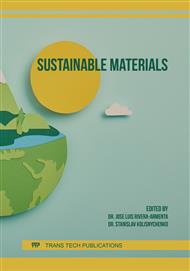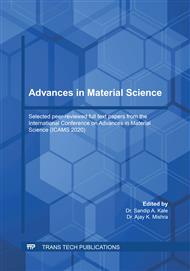[1]
Belgacem MN, Gandini A. Monomers, polymers and composites from renewable resources. Elsevier; (2008).
Google Scholar
[2]
Tuck CO, Perez E, Horvath IT, Sheldon RA, Poliakoff M. Valorization of biomass: deriving more value from waste. Science 2012, 337(6095): 695–9.
DOI: 10.1126/science.1218930
Google Scholar
[3]
Y. Zhu, C. Romain, C.K. Williams, Sustainable polymers from renewable resources, Nature 540 (2016) 354–362.
DOI: 10.1038/nature21001
Google Scholar
[4]
Meier MAR, Metzger JO, Schubert US. Plant oil renewable resources as green alternatives in polymer science. Chem Soc Rev 2007;36(11):1788.
DOI: 10.1039/b703294c
Google Scholar
[5]
C. Gioia, G. Lo Re, M. Lawoko, L. Berglund, Tunable thermosetting epoxies based on fractionated and well-characterized lignins, J. Am. Chem. Soc. 140 (2018) 4054–4061.
DOI: 10.1021/jacs.7b13620
Google Scholar
[6]
S. Wang, S. Ma, C. Xu, Y. Liu, J. Dai, Z. Wang, X. Liu, J. Chen, X. Shen, J. Wei, J. Zhu, Vanillin-derived high-performance flame retardant epoxy resins: facile synthesis and properties, Macromolecules 50 (2017) 1892–(1901).
DOI: 10.1021/acs.macromol.7b00097
Google Scholar
[7]
R. Auvergne, S. Caillol, G. David, B. Boutevin, J.P. Pascault, Biobased thermosetting epoxy: present and future, Chem. Rev. 114 (2014) 1082–1115.
DOI: 10.1021/cr3001274
Google Scholar
[8]
E. Santacesaria, R. Tesser, M. Di Serio, L. Casale, D. Verde, New process for producing epichlorohydrin via glycerol chlorination, Ind. Eng. Chem. Res. 49 (2010) 964–970.
DOI: 10.1021/ie900650x
Google Scholar
[9]
S. Ma, X. Liu, L. Fan, Y. Jiang, L. Cao, Z. Tang, J. Zhu, Synthesis and properties of a bio-based epoxy resin with high epoxy value and low viscosity, ChemSusChem 7 (2014) 555–562.
DOI: 10.1002/cssc.201300749
Google Scholar
[10]
H. Okada, T. Tokunaga, X. Liu, S. Takayanagi, A. Matsushima, Y. Shimohigashi, Direct evidence revealing structural elements essential for the high binding ability of bisphenol A to human estrogen-related receptor-gamma, Environ. Health. Persp. 116 (2008) 32–38.
DOI: 10.1289/ehp.10587
Google Scholar
[11]
M. Fache, E. Darroman, V. Besse, R. Auvergne, S. Caillol, B. Boutevin, Vanillin, a promising biobased building-block for monomer synthesis, Green Chem. 16 (2014) 1987–(1998).
DOI: 10.1039/c3gc42613k
Google Scholar
[12]
M. Fache, R. Auvergne, B. Boutevin, S. Caillol, New vanillin-derived diepoxy monomers for the synthesis of biobased thermosets, Eur. Polym. J. 67 (2015) 527–538.
DOI: 10.1016/j.eurpolymj.2014.10.011
Google Scholar
[13]
G. Yang, B.J. Rohde, H. Tesefay, M.L. Robertson, Biorenewable epoxy resins derived from plant-based phenolic acids, ACS Sustain. Chem. Eng. 4 (2016) 6524–6533.
DOI: 10.1021/acssuschemeng.6b01343
Google Scholar
[14]
I. Faye, M. Decostanzi, Y. Ecochard, S. Caillol, Eugenol bio-based epoxy thermosets: from cloves to applied materials, Green Chem. 19 (2017) 5236–5242.
DOI: 10.1039/c7gc02322g
Google Scholar
[15]
J. Qin, H. Liu, P. Zhang, M. Wolcott, J. Zhang, Use of eugenol and rosin as feedstocks for biobased epoxy resins and study of curing and performance properties, Polym. Int. 63 (2014) 760–765.
DOI: 10.1002/pi.4588
Google Scholar
[16]
Sahoo SK, Mohanty S, Nayak SK, Toughened bio-based epoxy blend network modified with transesterified epoxidized soybean oil: synthesis and characterization. RSC Adv 5 (2015), 13674–13691.
DOI: 10.1039/c4ra11965g
Google Scholar
[17]
Auvergne R, Caillol S, David G, Boutevin B, Pascault JP, Biobased thermosetting epoxy: present and future. Chem Rev 114(2) (2014), 1082–1115.
DOI: 10.1021/cr3001274
Google Scholar
[18]
SK Sahoo, V Khandelwal, G Manik, Sisal fibers reinforced epoxidized nonedible oils based epoxy green composites and its potential applications, Green Composites, 2019, pp.73-102.
DOI: 10.1007/978-981-13-1972-3_3
Google Scholar
[19]
Lu Y, Larock RC, Novel polymeric materials from vegetable oils and vinyl monomers: preparation, properties, and applications. Chemsuschem 2(2) (2009) 136–147.
DOI: 10.1002/cssc.200800241
Google Scholar
[20]
Guner, F.S., Yagci. Y. and Erciyes, A.T., Polymers from Triglyceride Oils. Progress in Polymer Science, 31 (2006), 633-670.
DOI: 10.1016/j.progpolymsci.2006.07.001
Google Scholar
[21]
Mustata F, Tudorachi N, Rosu D, Curing and thermal behavior of resin matrix for composites basedon epoxidized soybean oil/diglycidyl ether of bisphenol A, Composites: Part B 42. (2011) 1803-1812.
DOI: 10.1016/j.compositesb.2011.07.003
Google Scholar
[22]
Sahoo SK, Mohanty S, Nayak SK, Synthesis and characterization of bio-based epoxy blends from renewable resource based epoxidized soybean oil as reactive diluents, Chinese Journal of Polymer Science Vol. 33, No. 1, (2015), 137−152.
DOI: 10.1007/s10118-015-1568-4
Google Scholar
[23]
Kadam A, Pawar M, Yemul O, Thamke V , Kodam K, Biodegradable biobased epoxy resin from karanja oil, Polymer 72 (2015) 82-92.
DOI: 10.1016/j.polymer.2015.07.002
Google Scholar
[24]
Derawi D, Salimon J, Ahmed W A, Preparation of epoxidized palm olein as renewable material by using peroxy acids, The Malaysian Journal of Analytical Sciences, Vol 18 No 3 (2014), 584 – 591.
Google Scholar
[25]
O'Brien R D, Fats and Oils; Formulating and Processing for Applications, Technomic Publishing AG, Switzerland (1998).
Google Scholar
[26]
Dinda S, Ravisankar V , Puri P, Development of Bio-epoxide from Nahor ( Mesua ferrea Linn ) Oil, Journal of the Taiwan Institute of Chemical Engineers 65 (2016), 399–404.
DOI: 10.1016/j.jtice.2016.05.053
Google Scholar
[27]
Miao S D, Liu K, Wang P, Su Z G, Zhang S P, Preparation and Characterization of Epoxidized Soybean Oil-Based Paper Composite as Potential Water-Resistant Materials, J.Appl. Polym. Sci. 132 (2015), 41575-41575.
DOI: 10.1002/app.41575
Google Scholar
[28]
Pérez J D E, Haagenson D M, Pryor S W, Ulven C A, Wiesenborn D P, Production and characterization of epoxidized canola oil, Amer. Soc. Agricultural & Biological Engineers, Vol. 52(4) (2009), 1289-1297.
DOI: 10.13031/2013.27772
Google Scholar
[29]
Sahoo S K, Mohanty S, Nayak S K, Toughened bio-based epoxy blend network modified with transesterified epoxidized soybean oil: Synthesis and characterization, RSC Adv., 5 (2015), 13674–13691.
DOI: 10.1039/c4ra11965g
Google Scholar
[30]
Fu Q, Tan J, Han C, Zhang X, Fu B, Wang F, Zhu X, Synthesis and curing properties of castor oil-based triglycidyl ether epoxy resin, Polym Adv Technol. 2020; 1–9. https://doi.org/10. 1002/pat.4982.
DOI: 10.1002/pat.4982
Google Scholar
[31]
G. S. Sudha, Hemjyoti Kalita, Smita Mohanty & Sanjay Kumar Nayak, Castor Oil Modified by Epoxidation, Transesterification and Acrylation Process: Spectroscopic Characteristics, International Journal of Polymer Analysis and Characterization, (2017),.
DOI: 10.1080/1023666x.2017.1334171
Google Scholar
[32]
Samper M D , Ferri J M, Carbonell-Verdu A, Balart R, Fenollar O, Properties of biobased epoxy resins from epoxidized linseed oil (ELO) crosslinked with a mixture of cyclic anhydride and maleinized linseed oil, eXPRESS Polymer Letters Vol.13, No.5 (2019) 407–418.
DOI: 10.3144/expresspolymlett.2019.34
Google Scholar
[33]
Sahoo S K, Khandelwal V, Manik V, Influence of Epoxidized Linseed Oil and Sisal Fibers on Structure–Property Relationship of Epoxy Biocomposite, Polymer Composites (2018).
DOI: 10.1002/pc.24857
Google Scholar
[34]
Sahoo S K, Khandelwal V, Manik G, Development of toughened bio‐based epoxy with epoxidized linseed oil as reactive diluent and cured with bio‐renewable crosslinker, Polymers for Advanced Technologies 29 (1) (2018), 565-574.
DOI: 10.1002/pat.4166
Google Scholar
[35]
Fache, M., Auvergne, R., Boutevin, B., and Caillol, New vanillin-derived diepoxy monomers for the synthesis of biobased thermosets, European Polymer Journal, 2015, 67, 527-538.
DOI: 10.1016/j.eurpolymj.2014.10.011
Google Scholar
[36]
Liu J, Dai J,1, Wang S, Peng Y, Cao L, Liu X, Facile synthesis of bio-based reactive flame retardant from vanillin and guaiacol for epoxy resin, Composites Part B 190 (2020) 107926.
DOI: 10.1016/j.compositesb.2020.107926
Google Scholar
[37]
Mogheiseh M, Karimian R, Khoshsefat M, Vanillin-derived epoxy monomer for synthesis of bio-based epoxy thermosets: efect of functionality on thermal, mechanical, chemical and structural properties, Chem. Pap. (2020).
DOI: 10.1007/s11696-020-01164-8
Google Scholar
[38]
Shibata M, Ohkita T, Fully biobased epoxy resin systems composed of a vanillin-derived epoxy resin and renewable phenolic hardeners, European Polymer Journal 92 (2017), 165–173.
DOI: 10.1016/j.eurpolymj.2017.05.007
Google Scholar
[39]
Qi Y, Weng Z, Zhang K, Wang J, Zhang S, Liu C, Jian X, Magnolol-based bio-epoxy resin with acceptable glass transition temperature, processability and flame retardancy, Chemical Engineering Journal 387, (2020), 124115.
DOI: 10.1016/j.cej.2020.124115
Google Scholar
[40]
Jianglei Qin, Hongzhi Liu, Pei Zhang, Michael Wolcott, Jinwen Zhang, Use of eugenol and rosin as feedstocks for biobased epoxy resins and study of curing and performance properties, Polym Int (2013).
DOI: 10.1002/pi.4588
Google Scholar
[41]
Zhang Y, Li Y, Wang L, Gao Z, Kessler M R, Synthesis and Characterization of Methacrylated Eugenol as a Sustainable Reactive Diluent for a Maleinated Acrylated Epoxidized Soybean Oil Resin, (2017),.
DOI: 10.1021/acssuschemeng.7b01673.s001
Google Scholar
[42]
Prasad V, K Sekar , Soney Varghese, M.A. Joseph Enhancing mode 1 and mode 2 interlaminar fracture toughness of flax fiber reinforced epoxy composite with nano TiO2, Composites Part A 124, (2019), 105505.
DOI: 10.1016/j.compositesa.2019.105505
Google Scholar
[43]
Prasad V, Joseph M A, Sekar K., Investigation of mechanical, thermal and water absorption properties of flax fibre reinforced epoxy composite with nano TiO2 addition, Composites Part A 115, (2018), 360–370.
DOI: 10.1016/j.compositesa.2018.09.031
Google Scholar
[44]
Sankarlal S, Kuppusamy V, Fabrication of aluminium 6061-SiC-Al2O3 MMC and HMMC by stir casting technique and comparing the mechanical properties, International Journal of Mechanical and Production Engineering Research and Development, Vol. 8, Issue 1, 2018, 635-642.
DOI: 10.24247/ijmperdfeb201870
Google Scholar
[45]
Sathyaraj S, Kannan M, Spectra Fibre Reinforced Composite - A Review, International Journal of Science and Research Vol. 6, Issue 6, 2017, 689-692.
Google Scholar



